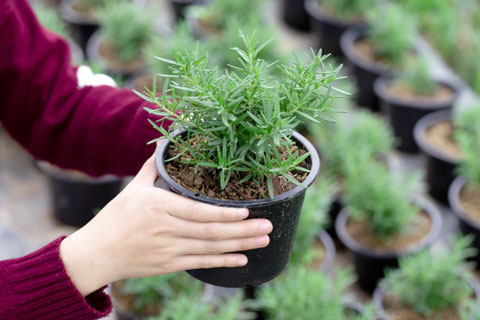11/1/2020
The Indoor Herbalist
Jennifer Polanz

Consumers, including new gardeners, turned out in droves to create their own backyard kitchen gardens. Edibles were one of the main drivers of the gardening uptick, as bare shelves and supply chain disruptions prompted more people to trying their hand at growing their own.
“I would say, in general, all edibles as a whole category were up,” says Ellen Bortner, greenhouse lead at Gardener’s Supply Co. in Williston, Vermont. Gardener’s Supply has four brick-and-mortar locations and a robust online business. “Folks are really turning to edibles, maybe for the first time. I spoke to a ton of folks who have never done this before and took this opportunity to start a garden.”
So how do we encourage continued growth? Indoor herbs is one way for new and long-time outdoor gardeners to bring their favorites inside for the winter. However, there are some key points to follow when helping customers make the transition.
The Right Plants
Not all herbs make great indoor plants and it’s important to carry ones that customers will be successful with. You may also have to contend with availability from your growers, especially this year.
“That’s one of the challenges we run into,” Ellen notes. “We still have one to two vendors that we’re able to source for organic herbs. We’re able to get those in.”
She adds the hardier herbs are the ones they promote for indoor growing. “I don’t find basil to be a super long-lived indoor herb, at least in Vermont, even if you’ve got nice grow lights,” she says. “We tend to focus on ones that are a little bit hardier: rosemary, sage and thyme. They can handle a little bit of water stress. Lavender is another one and sometimes mints. Not as many of the tender herbs, though.”
Laura Altvater, the color buyer and manager at Portland Nursery’s Stark location in Oregon, says they have signage pointing customers to specific choices.
“We have signs for the best-flavored rosemary, darkest lavenders, dwarf lavender,” she explains. “Most customers know what they use a lot of, so anything that helps them make a choice where there are multiple varieties of one herb is helpful.”
The Right Place
Ellen mentioned grow lights. Aside from choosing the right plants, the second-most important aspect is the lighting.
“So many indoor spaces do not have enough light for herbs,” Laura concurs. “A simple way to add light for growing herbs is a full-spectrum bulb.”
Ellen says they talk about light requirements through signage and also carry several tabletop light gardens for the kitchen. They merchandise them with pottery sets, window box-style planters and sets of three to six pots all within the herb section.
Another key Laura points out is making sure plants play nicely together and they have enough space to grow.
“Not all herbs play well with others. Mint should be in a pot all by itself,” she says. “Also, let customers know how big some herbs can get. Rosemary will grow into a good-sized shrub, so growing it in a pot with five other herbs will only work for so long. The plants will run out of root space.”
She recommends telling customers to plant in a pot that is about 2-in. larger in all directions than the size of the original grower pot.
An easy way around this, too, is to pot up the herbs in appropriate pottery and price accordingly. “We do have some premade herb pots that seem to sell well,” Laura adds. “In early spring, some of them have violas in them, as well, for a punch of color (not to mention edible flowers).”
Products to Cross-Merchandise
Of course, we’ve already talked about the plants, pots and growing lights, but there’s even more to think about with indoor herbs.
“A lot of times people don’t realize they need to be fed as often as they do,” Ellen says, recommending a low-dose liquid or granular fertilizer. They also can be susceptible to pests and she recommends a gentle insecticidal soap for those issues.
Laura notes that indoor herbs need humidity, and she recommends having a selection of saucers and small bags of rock or gravel, as well as images or tutorials showing customers how to make a humidity tray. It’s also a good opportunity to promote seed-starting kits and packet seeds for those looking to get a jumpstart on their spring gardens in late winter.
Avoiding the Pinterest Fail
Inspiration is great for new gardeners, but sites like Pinterest don’t always reflect how to appropriately plant or place items like indoor herbs so they thrive. Often, a window isn’t enough light and herbs hanging on a back wall just isn’t going to cut it.
“I think it’s mostly about having honest conversations,” Ellen says. “It’s super cute, but realistically you have to think about how much light these are going to get, and the fact that these tender herbs aren’t going to be super long-lived.”
Along with emphasizing proper lighting conditions, Laura says she would also make sure customers know herbs need good drainage, so growing them in cute pots without holes is a bad idea.
When it comes to education, both Laura and Ellen say they typically offer indoor herb-growing classes, although this year it might be better to coordinate Zoom events or offer YouTube videos. Workshops could be hosted via Zoom with customers pre-ordering kits online and picking them up in-store or curbside pick-up. Portland Nursery has a great printable handout detailing the “whats” and “hows” to indoor growing, as well as troubleshooting and additional resources.
“Another great tool that we didn’t utilize as much is social media,” adds Ellen. “You can put up informational posts: ‘Did you know they need to be fed?’ ‘Did you know you could grow herbs indoors in winter?’” GP